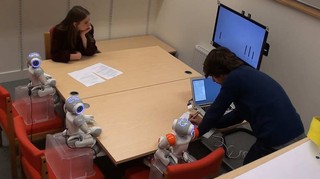Robots have power to significantly influence children’s opinions
A study published in Science Robotics provides an interesting insight into how robots could be used positively within society
Credit: Alan Williams
 |
| Credit: CITEC/Bielefeld University |
Young children are significantly more likely than adults to have their opinions and decisions influenced by robots, according to new research.
The study, conducted at the University of Plymouth, compared how adults and children respond to an identical task when in the presence of both their peers and humanoid robots.
It showed that while adults regularly have their opinions influenced by peers, something also demonstrated in previous studies, they are largely able to resist being persuaded by robots.
However, children aged between seven and nine were more likely to give the same responses as the robots, even if they were obviously incorrect.
The study used the Asch paradigm, first developed in the 1950s, which asks people to look at a screen showing four lines and say which two matches in length. When alone, people almost never make a mistake but when doing the experiment with others, they tend to follow what others are saying.
When children were alone in the room in this research, they scored 87 per cent on the test, but when the robots join in their score drops to 75 per cent. And of the wrong answers, 74 per cent matched those of the robot.
In their conclusion to the current study, the researchers add:
“A future in which autonomous social robots are used as aids for education professionals or child therapists is not distant. In these applications, the robot is in a position in which the information provided can significantly affect the individuals they interact with. A discussion is required about whether protective measures, such as a regulatory framework, should be in place that minimises the risk to children during social child-robot interaction and what form they might take so as not to adversely affect the promising development of the field.”
___________
Children put on by robots
Source: Bielefeld University |
| An adult participant in the study. Image: Vollmer et al., Sci. Robot. 3, eaat7111 (2018) |
Conducted by computer scientist Anna-Lisa Vollmer of the Cluster of Excellence Cognitive Interaction Technology (CITEC) at Bielefeld University as well as her colleagues from Plymouth University (United Kingdom), the Max Planck Institute for Human Development (Berlin) and Ghent University (Belgium), this study appeared on Wednesday (15.08.2018) in the scientific journal "Science Robotics."
The research team used the "conformity experiment" - the experiment psychologist Salomon Asch became known for in the 1950s. The experiment shows just how much a group can influence the opinion of an individual. "The test subjects are tasked with evaluating a visual image, and they hear the incorrect assessment from the others in the group - who are all 'in' on the experiment," explains Anna-Lisa Vollmer, who is a member of Applied Informatics, a research group led by Professor Dr. Britta Wrede that is part of the Faculty of Technology and CITEC.
In this new study, it is not people who are "in" on the experiment, but rather three Nao robots. These humanoid robots are able to speak and gesticulate, and are significantly smaller than adult humans (standing at approximately 60 centimeters). The study was divided into two parts. In the first phase of the experiment, the researchers investigated whether adults adjusted their assessment based on the one put forth by the three robots present. In the second phase, 7-9 year-old children took part in the experiment. The study participants viewed a vertical line on a screen. They had to compare the length of this line with three other lines (A, B, and C), and then say which of these lines was the same length. If the right answer was "B," the robot would, for instance, incorrectly claim that "C" was correct.
The results: "Children give into the social pressure induced by the group of robots," says Anna-Lisa Vollmer. "Adults, on the other hand, withstand this influence, even though they would be influenced by other humans in the same situation."
According to Vollmer, the factors responsible for the Nao robots exerting peer pressure or not have yet to be determined. The size of the Nao robots might be the reason why they were not able to influence the adults in this experiment. "Due to their appearance and size, the Nao robots might be more likely to be perceived as being on the same level by the children." That said, the researchers made effort to compensate for size: in both experiments, the robots' seat level was adjusted to that of the participants.
The current study is pioneering work: "Even though children are considered to be an important user group in the future, it is not really known what influence robots have on children, and how robot behaviour impacts childhood development," says Anna-Lisa Vollmer.
The results of this study are also of practical relevance for the use of humanoid robots. "There are applications in which having influence is advantageous, such as in healthcare or education," says Anna-Lisa Vollmer. "But of course we cannot disregard abuse or erroneous use. For example, how do we deal with a situation in which several robots in a store advertise a product and get a person to buy it even though they would not have done so otherwise? Other risks include cases in which autonomously learning robots draw incorrect conclusions from their sensory data and then go with this to people who trust the robot's assessment," as Vollmer explains.
__________
HUMAN-ROBOT INTERACTION
Children conform, adults resist: A robot group induced peer pressure on normative social conformity
Anna-Lisa Vollmer1, Robin Read, Dries Trippas and Tony Belpaeme
Science Robotics 15 Aug 2018: Vol. 3, Issue 21, eaat7111 DOI: 10.1126/scirobotics.aat7111

0 commenti :
Posta un commento